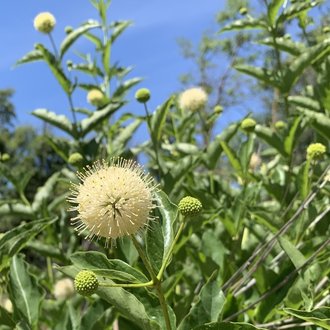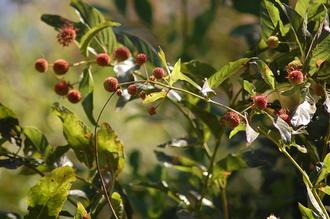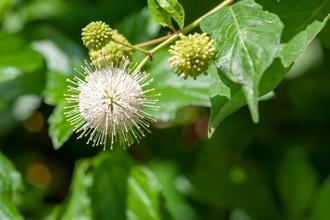Common Buttonbush (Cephalanthus occidentalis L.)
↑Summary
A shrub of sunny wetlands, native to much of North America, with distinctive globe-shaped clusters of tiny flowers.
↑Range - Expand
| Legend | Color |
| Native | |
| Native or Not Present |
This tentative map is based on our own research. It may have limited data on Canada and/or Mexico, and there is some subjectivity in our assignment of plants as introduced vs. expanded. Read more in this blog post.
Although this plant occurs somewhere in each of these regions, it may only occur in a small part of some or all of them.
↑Habitat
Found in wetlands, on sites that are sunny and experience intermittent flooding. Found in marshes, bogs, sunnier sites in swamps, ditches, and low-lying sites in floodplains. Usually absent from sites that are not inundated for at least some portion of the year.
On sites able to support taller trees, functions as a pioneer species, but can form more stable communities on sites not suitable for trees.
↑Faunal Associations
The seeds are eaten by numerous waterfoul and shorebirds. Wood ducks also use shrubs as cover and hiding places, especially during brood rearing. Deer browse this species; its importance to deer varies regionally, and is particularly valuable in Nova Scotia.
↑Uses
Occasionally planted in landscaping, where it is valued for its unusual blossoms and being generally easy to grow. In landscaping, able to be grown on drier sites than it would naturally occur, such as sites with consistently moist, but not waterlogged or flooded soil.
Although it is not typically used to produce single flower honey, this species has a high value in beekeeping, due to its long flowering period, high nectar production of its flowers, and pleasant fragrance. It is particularly important along the Mississippi river. (source)
↑Related Plants
In North America, the only other plant in its genus is Mexican buttonbush (Cephalanthus salicifolius), which is found from extreme south Texas through Mexico.
There are numerous other plants of the coffee or madder (Rubiaceae) family. However, none of these are particularly closely-related; this genus is the only member of the Naucleeae tribe found in North America; there are only a few members of the broader Cinchonoideae subfamily, mostly limited to southern Florida. The closely related genera are almost all limited to the tropics.
↑Links & External Resources
• Common Buttonbush | Fire Effects Information System (FEIS) (About This Site)
• Cephalanthus occidentalis (Buttonbush) | Illinois Wildflowers (About This Site)
• Cephalanthus occidentalis (Common Buttonbush) | USDA PLANTS Database (About This Site)
• Cephalanthus occidentalis | Go Botany (About This Site)
• Buttonbush | iNaturalist (About This Site)
• Cephalanthus occidentalis (Buttonbush) | Missouri Botanical Garden Plant Finder (About This Site)
• Buttonbush | Virginia Tech Dendrology Factsheets (About This Site)
• Cephalanthus occidentalis | Biota of North America Project (BONAP) (About This Site)
• Cephalanthus occidentalis | NatureServe Explorer (About This Site)
• Cephalanthus occidentalis | Missouri Plants (About This Site)
• Common Buttonbush | Maryland Biodiversity Project (About This Site)
• Cephalanthus occidentalis L. (Buttonbush) | Digital Atlas of the Virginia Flora (About This Site)








